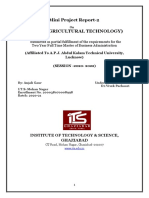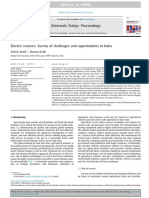robotics
robotics
Uploaded by
madhuvarsanmvCopyright:
Available Formats
robotics
robotics
Uploaded by
madhuvarsanmvCopyright
Available Formats
Share this document
Did you find this document useful?
Is this content inappropriate?
Copyright:
Available Formats
robotics
robotics
Uploaded by
madhuvarsanmvCopyright:
Available Formats
See discussions, stats, and author profiles for this publication at: https://www.researchgate.
net/publication/386546705
Robotics and Automation in Modern Agricultural Practices
Article · December 2024
DOI: 10.15515/abr.0976-4585.15.5.5560
CITATIONS READS
0 77
6 authors, including:
Mohd Ashaq Nikita Mishra
Govt Degree College Thannamandi, Jammu and Kashmir, India Bihar Agricultural University
32 PUBLICATIONS 33 CITATIONS 15 PUBLICATIONS 29 CITATIONS
SEE PROFILE SEE PROFILE
All content following this page was uploaded by Nikita Mishra on 08 December 2024.
The user has requested enhancement of the downloaded file.
Advances in Bioresearch
Adv. Biores., Vol 15 (5) September 2024: 55-60
©2024 Society of Education, India
Advances
Print ISSN 0976-4585; Online ISSN 2277-1573
Journal’s URL:http://www.soeagra.com/abr.html
in
CODEN: ABRDC3
DOI: 10.15515/abr.0976-4585.15.5.5560
Bioresearch
REVIEW ARTICLE
Robotics and Automation in Modern Agricultural Practices
Gaurav1, Mohd Ashaq2*, Yogendra Kumar Jyoti3, Nikita Mishra4, Anjali Dutt5, Pooja Gupta6
1Department of Agronomy, Faculty of Agriculture Science, Udai Pratap College, Varanasi, India
2* Department of Botany, Govt. Degree College, Thanamandi, Jammu and Kashmir, India
3 Processing and food engineering, CAET, OUAT, Bhubaneswar, Odisha, India
4 Department of Agriculture Engineering, KVK Aurangabad, Bihar, India.
5 Department of Botany, MMH College, Ghaziabad, Uttar Pradesh, 201001, India
6 Department of Molecular Microbiology and Immunology, CSIR-Central Drug Research Institute, India.
*Corresponding Author
ABSTRACT
The agricultural industry has witnessed significant advancements in recent years, with robotics and automation playing
a crucial role in revolutionizing modern farming practices. This article explores the impact of these technologies on
agriculture worldwide, with a specific focus on Asia and India. Integrating robotics and automation in agriculture has
led to increased efficiency, precision, and productivity while reducing labor costs and minimizing the environmental
impact of farming. Automated systems, such as autonomous tractors, drones, and robotic harvesters, have enabled
farmers to optimize crop management, improve resource utilization, and enhance crop quality. In Asia, countries like
China, Japan, and South Korea have been at the forefront of adopting agricultural robotics, driven by the need to address
labor shortages and increase food production. India, with its vast agricultural sector, has also recognized the potential of
these technologies and has initiated various projects and initiatives to promote their adoption. However, implementing
robotics and automation in agriculture faces challenges, including high initial costs, technical complexities, and the need
for skilled operators. This article provides an in-depth analysis of the current state of agricultural robotics and
automation, discussing their applications, benefits, and limitations. It also highlights the prospects of these technologies
and their potential to transform the agricultural landscape in the coming years. By embracing robotics and automation,
the agricultural industry can address the growing demand for food, ensure sustainable farming practices, and contribute
to the overall growth and development of the sector.
Keywords: Agricultural robotics, automation, precision agriculture, crop management, sustainable farming
Received 14.04.2024 Revised 20.05.2024 Accepted 24.07.2024
How to cite this article:
Gaurav, Mohd A, Yogendra K J, Nikita M, Anjali D, Pooja G. Robotics and Automation in Modern Agricultural Practices.
Adv. Biores. Vol 15 [5] September 2024. 55-60
INTRODUCTION
The agricultural industry has undergone significant transformations over the past few decades, with the
advent of robotics and automation playing a pivotal role in reshaping modern farming practices. As the
world population continues to grow, the demand for efficient and sustainable food production has
become increasingly critical. Robotics and automation have emerged as powerful tools to address the
challenges faced by the agricultural sector, offering innovative solutions to optimize crop yield, reduce
labor costs, and minimize the environmental impact of farming [1].
GLOBAL PERSPECTIVE ON AGRICULTURAL ROBOTICS AND AUTOMATION
Overview of Agricultural Robotics and Automation Agricultural robotics and automation encompass a
wide range of technologies designed to streamline and optimize various farming processes. These
technologies include autonomous tractors, drones, robotic harvesters, precision spraying systems, and
automated irrigation systems [2]. The primary goal of these technologies is to enhance efficiency, reduce
labor costs, and improve the overall quality and yield of crops.
Adoption of Robotics and Automation in Developed Countries Developed countries, such as the
United States, Canada, and European nations, have been at the forefront of adopting agricultural robotics
ABR Vol 15 [5] September 2024 55 | P a g e © 2024 Author
and automation. These countries have invested heavily in research and development, leading to the
creation of advanced technologies that have revolutionized farming practices [3]. For example, in the
United States, the use of precision agriculture techniques, such as GPS-guided tractors and variable rate
application of inputs, has become increasingly common [4].
Table 1: Adoption of Agricultural Robotics and Automation in Developed Countries
Country Autonomous Tractors Drones Robotic Harvesters Precision Spraying
USA High High Moderate High
Canada High High Moderate High
Germany High High Moderate High
France High High Moderate High
UK High High Moderate High
Australia High High Moderate High
Japan High High High High
South Korea High High High High
Netherlands High High Moderate High
Spain High High Moderate High
Benefits of Agricultural Robotics and Automation The adoption of robotics and automation in
agriculture has led to numerous benefits, including:
Increased efficiency and productivity
Reduced labor costs
Improved crop quality and yield
Optimized resource utilization (water, fertilizers, pesticides)
Minimized environmental impact
Enhanced precision in farming operations
Figure 1: Benefits of Agricultural Robotics and Automation
Challenges and Limitations Despite the numerous benefits, the implementation of agricultural
robotics and automation faces several challenges and limitations:
High initial costs of technology adoption
Technical complexities and the need for skilled operators
Lack of standardization and interoperability among different systems
Concerns regarding data privacy and security
ABR Vol 15 [5] September 2024 56 | P a g e © 2024 Author
Resistance to change among traditional farmers
Agricultural Robotics and Automation in Asia
Overview of Agriculture in Asia
Asia is home to a significant portion of the world's population and is a major contributor to global
agricultural production. Countries like China, India, Japan, and South Korea have large agricultural sectors
that play a crucial role in their economies [5]. However, the region faces numerous challenges, including
limited arable land, increasing labor costs, and the need to feed a growing population.
Adoption of Robotics and Automation in Asian Countries
Several Asian countries have recognized the potential of robotics and automation in addressing the
challenges faced by their agricultural sectors. China, Japan, and South Korea have been at the forefront of
adopting these technologies, driven by the need to increase productivity and efficiency in farming
operations [6].
Table 2: Adoption of Agricultural Robotics and Automation in Asian Countries
Country Autonomous Tractors Drones Robotic Harvesters Precision Spraying
China Moderate High Moderate High
Japan High High High High
South Korea High High High High
India Low Moderate Low Moderate
Indonesia Low Moderate Low Moderate
Thailand Low Moderate Low Moderate
Vietnam Low Moderate Low Moderate
Philippines Low Moderate Low Moderate
Malaysia Low Moderate Low Moderate
Taiwan Moderate High Moderate High
Case Studies of Successful Implementation
Several Asian countries have successfully implemented robotics and automation in their agricultural
sectors, leading to significant improvements in productivity and efficiency.
Japan: Robot-Assisted Farming Japan has been a pioneer in the development and adoption of agricultural
robots. The country has introduced various robots, such as the "Agri Robot" for harvesting strawberries
and the "Rice-Planting Robot" for transplanting rice seedlings [7]. These robots have helped farmers
overcome labor shortages and improve the efficiency of farming operations.
China: Drone-Based Crop Monitoring China has extensively used drones for crop monitoring and
precision agriculture. Drones equipped with cameras and sensors can collect data on crop health, soil
conditions, and pest infestations, enabling farmers to make informed decisions and optimize resource
utilization [8].
Challenges and Opportunities in Asia
Despite the successful implementation of robotics and automation in some Asian countries, the region
still faces challenges in widespread adoption. These challenges include:
High costs of technology adoption
Lack of technical expertise and trained personnel
Fragmented land holdings and small-scale farming
Inadequate infrastructure and support systems
Agricultural Robotics and Automation in India
Overview of Indian Agriculture
India is an agrarian economy, with agriculture contributing significantly to the country's GDP and
employing a large portion of the population. However, Indian agriculture faces numerous challenges,
including low productivity, fragmented land holdings, and dependence on monsoons [9].
Current State of Robotics and Automation in Indian Agriculture
The adoption of robotics and automation in Indian agriculture is still in its nascent stages. However, the
government and private sector have recognized the potential of these technologies and have initiated
various projects and initiatives to promote their adoption [10].
ABR Vol 15 [5] September 2024 57 | P a g e © 2024 Author
Table 3: Examples of Agricultural Robotics and Automation Projects in India
Project/Initiative Description Organization
Kisan Drone Drone-based crop monitoring and spraying Garuda Aerospace
Fasal AI-based crop intelligence platform Fasal
Tartan Sense Robotic weed management system Tartan Sense
Mitra Autonomous agricultural robot Mitra Agro Equipments
FarmERP Farm management software FarmERP
Agnext AI-based quality assessment of agricultural produce Agnext Technologies
CropIn AI-driven farm management platform CropIn Technology
Aibono AI-powered precision farming system Aibono
BharatRohan Drone-based crop monitoring and yield estimation BharatRohan Airborne Innovations
Intello Labs AI-based quality assessment of agricultural commodities Intello Labs
Government Initiatives and Policies
The Indian government has introduced various initiatives and policies to promote the adoption of
robotics and automation in agriculture. Some of these initiatives include:
National Agriculture Market (eNAM): An online platform for farmers to sell their produce directly
to buyers [11]
Kisan Credit Card (KCC) Scheme: Provides credit to farmers for purchasing agricultural inputs
and equipment [12]
National Mission on Agricultural Extension and Technology (NMAET): Aims to promote the
adoption of modern technologies in agriculture [13]
Challenges and Opportunities
The adoption of robotics and automation in Indian agriculture faces several challenges, including:
High costs of technology adoption
Lack of awareness and technical expertise among farmers
Inadequate infrastructure and support systems
Fragmented land holdings and small-scale farming
However, the increasing demand for food, the need to improve agricultural productivity, and the
government's focus on promoting technology adoption present significant opportunities for the growth of
agricultural robotics and automation in India.
Future Prospects and Trends
Precision Agriculture Precision agriculture, which involves the use of advanced technologies to optimize
crop management and resource utilization, is expected to gain more prominence in the coming years. The
integration of robotics, automation, and data analytics will enable farmers to make data-driven decisions
and implement precision farming techniques [14].
Figure 2: Components of Precision Agriculture
ABR Vol 15 [5] September 2024 58 | P a g e © 2024 Author
Autonomous Farming
The development of fully autonomous farming systems, where robots and automated machines perform
all the farming operations without human intervention, is a long-term goal for the agricultural industry.
While complete autonomy may still be a distant reality, the increasing adoption of autonomous tractors,
drones, and robotic harvesters is paving the way for a more automated future [15].
Table 4: Projected Global Market Size of Agricultural Robots (in USD Billion)
Year Market Size
2020 4.6
2021 5.4
2022 6.3
2023 7.4
2024 8.7
2025 10.2
2026 12.0
2027 14.1
2028 16.6
2029 19.5
Integration of Artificial Intelligence (AI) and Machine Learning (ML)
The integration of AI and ML in agricultural robotics and automation is expected to revolutionize farming
practices. AI algorithms can analyze vast amounts of data collected by sensors and drones to provide
insights on crop health, pest infestations, and resource optimization [16]. ML models can continuously
learn and adapt to changing conditions, enabling more accurate predictions and decision-making.
Collaborative Robots (Cobots)
Collaborative robots, or cobots, are designed to work alongside human workers, assisting them in various
farming tasks. Cobots can enhance productivity and reduce the physical strain on farmers, especially in
labor-intensive operations like harvesting and pruning [17]. The development of more advanced and
affordable cobots is expected to drive their adoption in the agricultural sector.
CONCLUSION
The integration of robotics and automation in modern agricultural practices has the potential to
revolutionize the way we produce food. These technologies offer numerous benefits, including increased
efficiency, precision, and productivity, while reducing labor costs and minimizing the environmental
impact of farming.The adoption of agricultural robotics and automation varies across different regions,
with developed countries and some Asian nations leading the way. India, with its vast agricultural sector,
has recognized the potential of these technologies and has initiated various projects and initiatives to
promote their adoption.
However, the implementation of robotics and automation in agriculture faces challenges, such as high
initial costs, technical complexities, and the need for skilled operators. Addressing these challenges and
creating an enabling environment for technology adoption is crucial for realizing the full potential of
agricultural robotics and automation. As we look towards the future, trends such as precision agriculture,
autonomous farming, AI integration, and collaborative robots are expected to shape the agricultural
landscape. By embracing these technologies and leveraging their potential, the agricultural industry can
address the growing demand for food, ensure sustainable farming practices, and contribute to the overall
growth and development of the sector.
REFERENCES
1. Lowenberg-DeBoer, J., Huang, I. Y., Grigoriadis, V., & Blackmore, S. (2020). Economics of robots and automation
in field crop production. Precision Agriculture, 21(2), 278-299.
2. Shamshiri, R. R., Weltzien, C., Hameed, I. A., Yule, I. J., Grift, T. E., Balasundram, S. K., ... & Chowdhary, G. (2018).
Research and development in agricultural robotics: A perspective of digital farming. International Journal of
Agricultural and Biological Engineering, 11(4), 1-14.
3. Duckett, T., Pearson, S., Blackmore, S., & Grieve, B. (2018). Agricultural robotics: The future of robotic agriculture.
UK-RAS White Papers.
4. Schimmelpfennig, D. (2016). Farm profits and adoption of precision agriculture. USDA-ERS Economic Research
Report, (217).
5. Food and Agriculture Organization of the United Nations. (2020). FAO Statistical Yearbook 2020: Asia and the
Pacific Food and Agriculture. FAO.
ABR Vol 15 [5] September 2024 59 | P a g e © 2024 Author
6. Peng, Y., & Zhang, Q. (2021). Agricultural robots in Asia: Current status and future directions. IEEE Access, 9,
50577-50589.
7. Otsuka, K., & Sugihara, K. (2020). Robots in Japanese agriculture: Current and future outlook. Journal of Robotics
and Mechatronics, 32(2), 301-309.
8. Huang, Y., & Zhou, H. (2021). Application of UAV remote sensing in precision agriculture in China. Frontiers in
Plant Science, 12, 646545.
9. Gulati, A., Sharma, P., & Samantara, A. (2021). Indian agriculture: Challenges and prospects. Agricultural
Economics Research Review, 34(1), 1-15.
10. Kalam, A., & Rao, R. (2021). Robotics and automation in Indian agriculture: A review. International Journal of
Robotics and Automation, 36(2), 119-128.
11. Small Farmers' Agribusiness Consortium. (2021). eNAM: Revolutionizing agricultural markets. Ministry of
Agriculture & Farmers' Welfare, Government of India.
12. National Bank for Agriculture and Rural Development. (2021). Kisan Credit Card Scheme. NABARD.
13. Department of Agriculture, Cooperation & Farmers Welfare. (2021). National Mission on Agricultural Extension
and Technology (NMAET). Ministry of Agriculture & Farmers' Welfare, Government of India.
14. Srinivasan, A. (2006). Handbook of precision agriculture: Principles and applications. CRC Press.
15. Reddy, N., Reddy, A., Pranavadithya, S., & Kumar, J. (2016). A critical review on agricultural robots. International
Journal of Mechanical Engineering and Technology, 7(4), 183-188.
Copyright: © 2024 Author. This is an open access article distributed under the Creative Commons Attribution
License, which permits unrestricted use, distribution, and reproduction in any medium, provided the original work is
properly cited.
ABR Vol 15 [5] September 2024 60 | P a g e © 2024 Author
View publication stats
You might also like
- Crop-Yield and Price Forecasting Using Machine LearningDocument8 pagesCrop-Yield and Price Forecasting Using Machine LearningMahesh VepuriNo ratings yet
- Agriculture ProjectDocument53 pagesAgriculture ProjectRamaRajuK67% (6)
- Agriculture BrandingDocument11 pagesAgriculture BrandingH.RAJU MNo ratings yet
- 27.2022 JEA ApplicationofroboticsinAg FullDocument6 pages27.2022 JEA ApplicationofroboticsinAg Fulljachan715No ratings yet
- agriculture technologyDocument31 pagesagriculture technologyajamns0007No ratings yet
- Sustainability 15 04821 v3Document20 pagesSustainability 15 04821 v3Algoritma PemrogramanNo ratings yet
- Mini Project Report 2Document31 pagesMini Project Report 2Anjali Gaur100% (2)
- PagesfromISAE2021 22Document18 pagesPagesfromISAE2021 22Sarvesh DharmeNo ratings yet
- ReportDocument17 pagesReportDarshanNo ratings yet
- Solar Powered Multipurpose Agriculture RobotDocument8 pagesSolar Powered Multipurpose Agriculture RobotInternational Journal of Innovative Science and Research TechnologyNo ratings yet
- Vol 7 SIssue 1 12Document4 pagesVol 7 SIssue 1 12Dr. Vishal S. PatilNo ratings yet
- He's Into Her Season 2Document7 pagesHe's Into Her Season 2aichrisz297No ratings yet
- Cultivating Change : Robotics in Agriculture and the Future of Food ProductionFrom EverandCultivating Change : Robotics in Agriculture and the Future of Food ProductionNo ratings yet
- Design and Fabrication of Multipurpose Agricultural Mini Farm Vehicle Using Scooter EngineDocument10 pagesDesign and Fabrication of Multipurpose Agricultural Mini Farm Vehicle Using Scooter EngineTony StarkNo ratings yet
- Design And) Abrication of A Solar Powered2021Document8 pagesDesign And) Abrication of A Solar Powered2021Noureldin SharabyNo ratings yet
- Chapter - AIbasedyieldprediction Pages 165 190Document27 pagesChapter - AIbasedyieldprediction Pages 165 190Poornima ANo ratings yet
- Ref 2Document4 pagesRef 2Niharika DhingraNo ratings yet
- Research Report - Agritech in IndiaDocument10 pagesResearch Report - Agritech in IndiaRushil PethadNo ratings yet
- Design and Fabrication of Multipurpose Agricultural Mini Farm Vehicle Using Scooter EngineDocument10 pagesDesign and Fabrication of Multipurpose Agricultural Mini Farm Vehicle Using Scooter Enginenagaraju b 334No ratings yet
- Adoption and Utilization of Drones For Advanced Precision Farming: A ReviewDocument3 pagesAdoption and Utilization of Drones For Advanced Precision Farming: A ReviewEditor IJRITCCNo ratings yet
- 2hsiahsvsiajwjwjDocument12 pages2hsiahsvsiajwjwjjohnhenriagravanteNo ratings yet
- Pargietal 2024Document19 pagesPargietal 2024Alex JoshyNo ratings yet
- Educating Farmersin Artificial Intelligence AIand Io TDocument7 pagesEducating Farmersin Artificial Intelligence AIand Io Tmayura bijaleNo ratings yet
- GJRALS240142Document12 pagesGJRALS240142Seid HussenNo ratings yet
- Farm Mechanization Innovation Capacity and Rice Productivity: Evidence From Small Scale Rice Farmers in Kwara State, NigeriaDocument6 pagesFarm Mechanization Innovation Capacity and Rice Productivity: Evidence From Small Scale Rice Farmers in Kwara State, NigeriaInternational Journal of Innovative Science and Research TechnologyNo ratings yet
- Drone Booklet LowDocument36 pagesDrone Booklet Lowjsingh_nsitNo ratings yet
- BodyDocument83 pagesBodyarunantony100% (1)
- BookchapterMarch2024 169 199Document32 pagesBookchapterMarch2024 169 199mshashank8867No ratings yet
- Review Article A Study On Fin-Tech in Indian Agricultural SectorDocument3 pagesReview Article A Study On Fin-Tech in Indian Agricultural SectorAnuranjani DhivyaNo ratings yet
- Agricultural Extension Approaches To Enhance The KDocument11 pagesAgricultural Extension Approaches To Enhance The Klusandadabula02No ratings yet
- An Effectual Design of Agribot and Novel Implementation For Smart AgricultureDocument9 pagesAn Effectual Design of Agribot and Novel Implementation For Smart AgricultureMohammed KhaliqNo ratings yet
- Sustainable Agriculturewith AIand RoboticsDocument4 pagesSustainable Agriculturewith AIand RoboticsThe SangeNo ratings yet
- Automatic Irrigation Model Powered by Smart Rain PDocument17 pagesAutomatic Irrigation Model Powered by Smart Rain PRAUSHAN KUMARNo ratings yet
- Agricultural Extension Approachesto EnhancetheDocument11 pagesAgricultural Extension Approachesto EnhancetheBhumika AndolaNo ratings yet
- Materials Today: Proceedings: Ashish Malik, Shivam KohliDocument7 pagesMaterials Today: Proceedings: Ashish Malik, Shivam KohliSenthil KumarNo ratings yet
- IJNRD2305286Document11 pagesIJNRD2305286HIMANSHU SINGHNo ratings yet
- Design & Fabrication of Organic Fertilizer Manufacturing MachineDocument4 pagesDesign & Fabrication of Organic Fertilizer Manufacturing Machinesuvarnalatha devarakondaNo ratings yet
- Paper 13690Document10 pagesPaper 13690Dr. Vishal S. PatilNo ratings yet
- Dual Purpose Agri Robot Muthu Vinoth of 9-j1Document13 pagesDual Purpose Agri Robot Muthu Vinoth of 9-j1bbggamers1418No ratings yet
- 4719138276a627e Food Processing and Related IndustriesDocument27 pages4719138276a627e Food Processing and Related IndustriesbuchakshaNo ratings yet
- Productivity and Energetics of Raising Rice-ArharDocument10 pagesProductivity and Energetics of Raising Rice-ArharrichaNo ratings yet
- Farmers Purchasing Behavior 2023Document13 pagesFarmers Purchasing Behavior 2023JonyNo ratings yet
- Design and Fabrication of Spraying MachineDocument9 pagesDesign and Fabrication of Spraying MachineIJRASETPublicationsNo ratings yet
- IJRTI2210061Document3 pagesIJRTI2210061Villan teamNo ratings yet
- Acknowledgment SeminarDocument26 pagesAcknowledgment Seminarparag WadhaiNo ratings yet
- 5322-Article Text-9506-4-10-20230527Document5 pages5322-Article Text-9506-4-10-20230527afreenmehatajNo ratings yet
- Agritech Startup: Business PlanDocument20 pagesAgritech Startup: Business PlanMoriba KABA100% (1)
- Roshan NTCC WPRDocument7 pagesRoshan NTCC WPRShivam MaheshwariNo ratings yet
- DissertationDocument14 pagesDissertationRaman BansalNo ratings yet
- Automatic Multipurpose Agribot Using Arduino Mega and GPS Module ReceiverDocument9 pagesAutomatic Multipurpose Agribot Using Arduino Mega and GPS Module ReceiverInternational Journal of Innovative Science and Research TechnologyNo ratings yet
- Utilizing Artificial Intelligence (AI) For Sustainable AgricultureDocument5 pagesUtilizing Artificial Intelligence (AI) For Sustainable AgricultureNamanNo ratings yet
- AgribotDocument8 pagesAgribotShreyash patilNo ratings yet
- Harnessing IoT and Machine Learning For SustainablDocument15 pagesHarnessing IoT and Machine Learning For SustainablJayesh PatilNo ratings yet
- AI in AgricultureDocument20 pagesAI in AgricultureUsama Patel100% (1)
- Ijireeice 2022 10489Document6 pagesIjireeice 2022 10489Hritik Tiwari CSE 30No ratings yet
- Smart Farming Automationand Roboticsin AgricultureDocument31 pagesSmart Farming Automationand Roboticsin Agriculturealiahmed.iba95No ratings yet
- Modern Agricultural TechniquesDocument19 pagesModern Agricultural TechniquesVikas VermaNo ratings yet
- Mcda 000792Document2 pagesMcda 000792Javier MartinNo ratings yet
- Design and Fabrication of A Multipurpose Agriculture RobotDocument10 pagesDesign and Fabrication of A Multipurpose Agriculture RobotIJRASETPublicationsNo ratings yet
- AGN AssignmentDocument4 pagesAGN Assignmentsadmanshahirar123No ratings yet
- Remote Farming : Harnessing Automation and Robotics in AgricultureFrom EverandRemote Farming : Harnessing Automation and Robotics in AgricultureNo ratings yet
- The Seven Natural Wonders of The PhilippinesDocument8 pagesThe Seven Natural Wonders of The PhilippinesfranNo ratings yet
- Pdms Commands Mostly StructrualDocument3 pagesPdms Commands Mostly StructrualMOHAMMAD ASIFNo ratings yet
- Mechnization For Post Harvest of GroundnutDocument10 pagesMechnization For Post Harvest of GroundnutDavara Paresh R.100% (1)
- Resisting ThefloodDocument23 pagesResisting ThefloodPugh JuttaNo ratings yet
- Genetically Modified Organisms: Earth & Life ScienceDocument3 pagesGenetically Modified Organisms: Earth & Life ScienceCold Af100% (1)
- Dolphin Model Cattle Farm, KailaliDocument3 pagesDolphin Model Cattle Farm, KailaliLok Raj JoshiNo ratings yet
- Biology Unit 2 Module 2 Biodiversity NotesDocument8 pagesBiology Unit 2 Module 2 Biodiversity NotescrystalNo ratings yet
- Master Plan.Document1 pageMaster Plan.Hikmat AyerNo ratings yet
- Multiple Choice QuestionsDocument4 pagesMultiple Choice QuestionsMohak100% (1)
- Paper 1 General Studies-I: Indian Heritage and Culture, History and Geography of The World and SocietyDocument4 pagesPaper 1 General Studies-I: Indian Heritage and Culture, History and Geography of The World and Societyanon_56564465No ratings yet
- Carrying CapacityDocument2 pagesCarrying CapacityPangiDoank100% (2)
- Eu Sme Centre Guideline Exporting Meat Products To ChinaDocument21 pagesEu Sme Centre Guideline Exporting Meat Products To ChinaValeria DumitrescuNo ratings yet
- Daily Lesson Log Week 3Document4 pagesDaily Lesson Log Week 3leonorsabado44No ratings yet
- Emaga Et Al 2007 Effects of The Stage of Maturation and Varieties On The Chemical Composition of Banana and Plantain PeelsDocument11 pagesEmaga Et Al 2007 Effects of The Stage of Maturation and Varieties On The Chemical Composition of Banana and Plantain PeelsSamantha Rosas RosasNo ratings yet
- Price List 2024Document12 pagesPrice List 2024vidhya1393No ratings yet
- Review 7Document4 pagesReview 7nguyen le an thaiNo ratings yet
- Cape Bon (Tunisia) Cape Agulhas Cape VerdeDocument24 pagesCape Bon (Tunisia) Cape Agulhas Cape VerdeGetnet HabtewoldNo ratings yet
- Hygienic Milk Handling and Processing by FAODocument7 pagesHygienic Milk Handling and Processing by FAOChevronelleNo ratings yet
- Engendering Nationalism. Identity Discourse and The Mexican CharroDocument15 pagesEngendering Nationalism. Identity Discourse and The Mexican CharroSVHNo ratings yet
- Soil Mechanics - Chapter 3Document9 pagesSoil Mechanics - Chapter 3محمد جواد كاظمNo ratings yet
- PAES 601 2016 - V11 - General Irrigation TerminologiesDocument16 pagesPAES 601 2016 - V11 - General Irrigation TerminologiesHoven Santos II100% (1)
- 08 153 PDFDocument27 pages08 153 PDFalanlima92No ratings yet
- Embedded Autonomy or Crony Capitalism Explaining Corruption in South Korea Relative To Taiwan and The Philippines Focusing On The Role of Land Reform and Industrial PolicyDocument45 pagesEmbedded Autonomy or Crony Capitalism Explaining Corruption in South Korea Relative To Taiwan and The Philippines Focusing On The Role of Land Reform and Industrial PolicyaalozadaNo ratings yet
- Company Name-Shri Ganesh Enterprises, Sangli Title - The Study of Quality of Raw Material of Used and Consumer Support of SG Foods in SangliDocument37 pagesCompany Name-Shri Ganesh Enterprises, Sangli Title - The Study of Quality of Raw Material of Used and Consumer Support of SG Foods in SangliPranav BedmuthaNo ratings yet
- Chapter-2 AgricultureDocument31 pagesChapter-2 AgricultureKhánh HuyềnNo ratings yet
- SumanDocument32 pagesSumanjagdeepgaggu93No ratings yet
- Carry Out Harvest and PostharvestDocument67 pagesCarry Out Harvest and PostharvestAllen Jade PateñaNo ratings yet
- Improvement in Food Resources: One Mark QuestionsDocument9 pagesImprovement in Food Resources: One Mark QuestionsSrividhya ManikandanNo ratings yet
- Rice Seed ProductionDocument8 pagesRice Seed ProductionrioabineshvjNo ratings yet

























































































